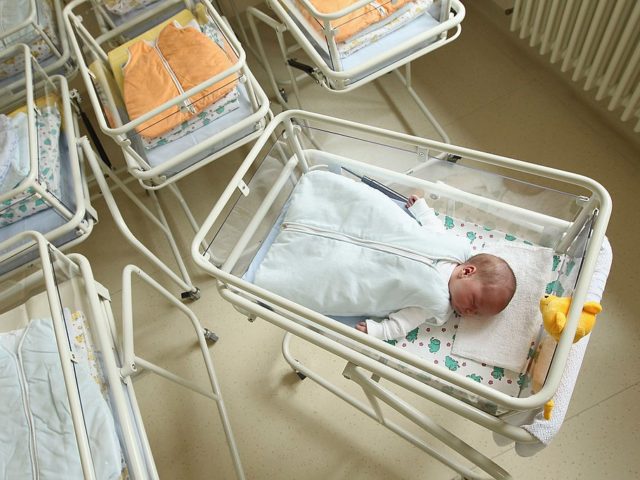Germany has bucked years of birth rate decline with a sudden ten per cent surge in new children coming nine months after lockdowns ended and bars reopened in summer 2020.
Births in Germany hit a 20-year-high in March 2021, the latest release from the national statistical agency (De Statis) reveals, with 65,903 children born in the month. This represents a massive ten per cent rise on March 2020 and is the highest level of March births since 1998.
De Statis note a correlation between births and the coronavirus lockdown. While the number of children born who were conceived during the early 2020 lockdown was broadly normal, when society started to open up again births started climbing.
Children born in February 2021, which corresponded with the first signs of lockdown ending in May 2020, were already up six per cent. The ten per cent surge by March 2021 corresponds to the summer suspension of lockdown in Germany, which saw groups able to socialise again and — quite possibly, crucially — pubs and bars allowed to reopen.
In recent years, Germany’s birth rate has fallen so steeply it became the lowest in Europe, and then ‘overtook’ Japan to become the lowest in the world in 2015.
While many major European nations saw a precipitous fall in births — already generally well below the so-called replacement rate continent-wide — coinciding with the pandemic, some have seen recoveries or even booms. Finland is one such country that has cited a coronavirus baby boom with a ten per cent gain in March.
Why different nations have seen different fertility responses to the pandemic and lockdown remains an open question, but a hypothesis has been offered. Germany’s De Statis notes a sudden fall in births in countries with very high coronavirus death rates, which Germany has not experienced.
A May report from the Reuters news agency has cited new pro-family policies enacted by the German government in the past decade as being a help to professional middle-class women who might otherwise miss out on motherhood. Until very recently, any policies promoting childbearing was compared unfavourably to the pro-natalism of Nazi-era Germany, possibly a contributing factor to the fact that more people have died than been born in Germany every year since the 1970s.
Also invoked in the report was Germany’s extremely high levels of immigration, thanks largely to the Europe Migrant Crisis, over the same period which has seen large numbers of young people from cultures associated with significantly higher birthrates arrive. Migrant mothers’ birth rates stood at a significant 2.3 in 2016, it claimed, compared to Germany’s average of 1.6. But even this epoch-defining migratory flow is not a long term solution to Germany’s demographic puzzle, it seems, as upon exposure to German culture and the obstacles thrown in the way of family life common to Western societies, the birth rates of migrant mothers do start to fall almost immediately.
Another European nation experiencing growth in birth rates is Hungary, although their government is less shy about giving couples support to start families. De Statis notes Hungary was one of the nations that saw a ten per cent bounce in March, a move against what the government in Budapest identifies as a “demographic crisis” that is to be fought and defeated.
Among the new measures in place in Hungary in recent years are special — and significant — tax breaks for families and young people, large loans for helping establish households for new families which do not have to be repaid if a couple has three children, and free IVF treatment.
Speaking to Breitbart London in February, Hungarian Families Minister Katalin Novák said she believes her nation will be better prepared to bounce back from the coronavirus baby-bust than other European nations because of a decade of these pro-family policies already being in place and having an impact before coronavirus took hold.
Advances in birth rates following the easement of lockdowns last summer or not, it remains the case that nations across Europe are not even close to maintaining a stable population without the aid of immigration from countries outside the bloc. Birthrates in the UK were already at historic lows before coronavirus, with 82 per cent of all population growth in the early part of the 21st century down to immigration, rather than natural growth.
The United States does not escape, either. The CDC announced in May that the U.S. birthrate saw the largest fall in nearly 50 years, hitting the lowest rate of births on record. Although births in the figures may have been impacted by coronavirus, many pregnancies were already underway before the pandemic began, pointing to wider problems, the report said.
And despite the spike of births in countries like Germany now that coincides with the reopening of pubs and bars last summer, demographers say there is no hope on the horizon for Europe’s demographics. The Wall Street Journal cited the remarks of Tomas Sobotka of the Wittgenstein Center for Demography and Global Human Capital in a March report when he said of the situation: “All evidence points to a sharp decline in fertility rates and in the number of births across highly developed countries.
“The longer this period of [coronavirus induced] uncertainty lasts, the more it will have lifelong effects on the fertility rate.”

COMMENTS
Please let us know if you're having issues with commenting.